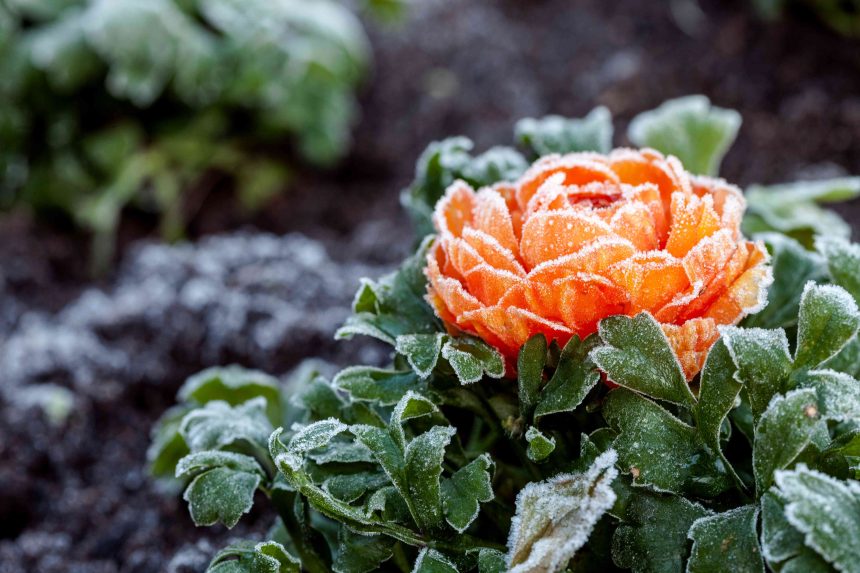Spring will be here before you know it, which means it’s time to start thinking about waking up your garden for the season. After prolonged periods of freezing temperatures or heavy snowfall, your yard is practically begging for a pick-me-up. While certain hardy plants can bounce back quickly after a harsh winter, others need some assistance. Ahead, we’re sharing tips from gardening and landscaping experts to help you revive your garden after winter.
Clean Up Flower Beds
Winter’s fallen leaves, twigs, and large branches will crowd out your spring flowers. Give them space to grow by cleaning up flower beds ahead of the season. “At the start of the year, color tends to be smaller in scale, so give it some room to grow,” says gardening author Lucy Bellamy. “Snowdrops, daffodils, and later tulips have their own rhythms and will start growing as soon as conditions are in their favor.” But you can help give these flowers a fresh start by preparing the flower beds for their reemergence ahead of time.
Keep Some Leaves
That said, fight the urge to remove all fallen leaves. “Many insects and invertebrates, such as native bees, moths, and butterflies, overwinter in fallen leaves and hollow stems of perennials and grasses,” says Emma Martone, curator of gardens at High Point University.
Removing these beneficial insects prematurely is detrimental to biodiversity and can affect your garden’s overall well-being. Martone recommends cleaning up beds around high traffic or highly visible spots like your front walkway. “For less visible areas, permit yourself to do less work by leaving the leaves to benefit nature,” she says.”
Mulch Around Bulbs
kobeza / GETTY IMAGES
Add mulch around bulbs once they start to grow to help the soil retain moisture. “As a general rule, mulch when the spring bulbs start coming up,” says Laura Janney, owner of The Inspired Garden. Add about 2 to 4 inches of mulch for the best results. Add too much, and your flower bed can accumulate with fungus and root rot, but add too little, and the mulch doesn’t serve its purpose, Janney says. Use natural mulch, as dyed mulches may contain toxins that don’t break down and contaminate the soil.
Add Houses for Butterflies and Birds
Welcome essential pollinators to your garden by hanging houses for butterflies and birds. Pollinators will give your garden a helping hand once the dregs of winter are over. Birds will eat insects you don’t want in your garden, while butterflies help pollinate flowers. “Learning about the needs of other creatures with whom we share our gardens, such as pollinators and birds, can guide some of our gardening practices and lead to spaces that are healthy, diverse, and thriving,” says Martone.
Prune Garden Shrubs
Pruning garden shrubs stimulates growth and prevents diseases. Plus, pruning allows you to control the shape and size of your plants so they fit with the aesthetics of your landscape. Research the shrubs growing in your garden and see if they benefit from late winter or early spring pruning. “Always use clean, sharp tools and cut at a 45-degree angle away from the plant,” Janney says. “And always cut above the node and never cut more than 1/3 of a shrub, as it can cause stress and damage to the plant.”
Aerate Your Lawn
Aerating your lawn improves soil chemistry and texture. “Aeration loosens the soil and reduces compaction, making it easier for roots to grow and allowing air and water to penetrate the soil,” Martone says. Aerating your soil in late winter or early spring is a great way to help revive your garden and green spaces, especially after heavy snowfalls may have compacted your soil. “Roots need oxygen, and without oxygen in the soil, roots suffer,” she says. Oxygen is also essential to microorganisms and insects in the soil, which contribute to soil health.
Remove Weeds
Javier Fernández Sánchez / Getty Images
Some prolific weeds, including bittercress, chickweed, deadnettle, and groundsel, can wreak havoc on your garden during winter. Prevent these weeds from taking nutrients from desirable garden plants by removing them as soon as the snow melts.
Plant After the Last Frost
Early spring is a great time to plant new vegetables and flowers. “However, it’s important not to jump the gun,” Martone warns. Surprise late spring frosts can kill burgeoning frost-sensitive plants. Check seed packets before planting, which will tell you when to sow the seeds based on your area’s last frost date. “Planting accordingly will help you not fall victim to a string of unseasonably warm days that tempt you into the garden,” says Martone.







